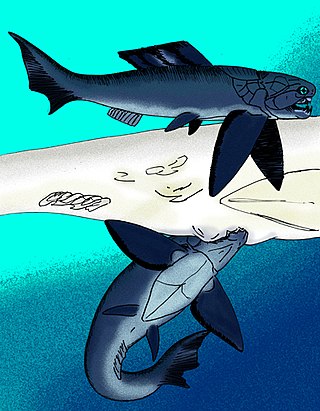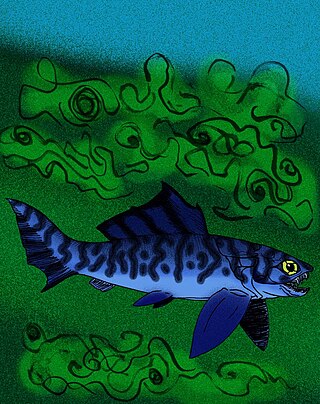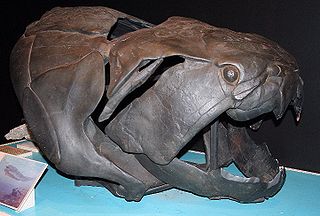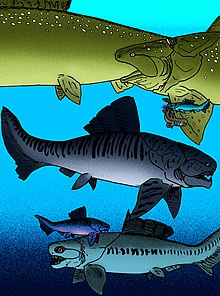
Dinichthys is an extinct monospecific genus of large marine arthrodire placoderm from the Late Devonian measuring around 3 metres (9.8 ft) long. Fossils were recovered from the Ohio Shale Formation along the Olentangy River in Delaware County, Ohio.

Brachythoraci is an extinct suborder of arthrodire placoderms, armored fish most diverse during the Devonian.

Coccosteina is an extinct infraorder of placoderms, armored fish most diverse during the Devonian. However, the term is no longer in use, as modern cladistical methods have produced alternative phylogenetic trees of Brachythoraci with new subdivisions.

The Dinichthyloidea is an extinct superfamily of placoderms, armored fish most diverse during the Devonian. However, the term is no longer in use, as modern cladistical methods have produced alternative phylogenetic trees of Brachythoraci with new subdivisions.

Rhachiosteus is an extinct monospecific genus of arthrodire placoderm from the Middle to Late Devonian of Germany. It is known only from a single specimen, which may be a larval or juvenile form, as the skull of said specimen is only 19 millimetres long.

Bruntonichthys is an extinct monospecific genus of arthrodire placoderm from the Early Frasnian stage of the Late Devonian period. Fossils are found in the Gogo Formation of the Kimberley region of Australia. The skull is about 139 millimetres long, and had disproportionally large eye sockets. Researchers suggest it may have preyed on small mollusks.

Aspinothoracidi is a clade of placoderms, extinct armored fish most diverse during the Devonian. The gigantic apex predator Dinichthys, is the best-known member of this group. Many other genera, such as the infamous Dunkleosteus, were previously thought to be close relatives of Dinichthys and were grouped together in the family Dinichthyidae, though more recent studies have restricted that family to only its type species.

Fallacosteus is an extinct monospecific genus of arthrodire placoderm from the Early Frasnian stage of the Late Devonian period, found at the Gogo Formation of Kimberley, Western Australia. As with almost all other camuropiscids, F. turneri had an elongated snout that may have enhanced its hydrodynamic streamlining.

Camuropiscis is an extinct genus of arthrodire placoderm from the Early Frasnian stage of the Late Devonian period, found at the Gogo Formation of Kimberley, Western Australia. The species of Camuropiscis had a flattened, elongated snout that may have aided in enhancing its hydrodynamic streamlining.

Latocamurus is an extinct monospecific genus of flat-nosed arthrodire placoderm from the Early Frasnian stage of the Late Devonian period, found at the Gogo Formation of Kimberley, Western Australia.

Dunkleosteoidea is an extinct superfamily of arthrodire placoderms that lived during the Devonian period. The gigantic apex predator Dunkleosteus terrelli is the best known member of this group.

Eubrachythoraci is an extinct clade of arthrodire placoderms within the suborder Brachythoraci, armored fish most diverse during the Devonian. Most are considered to be pelagic long-distance swimmers, leading to their widespread distribution beginning from at least the Middle Devonian period.
Golshanichthys is an extinct monospecific genus of dunkleosteid from the Late Devonian: Frasnian stage from Kerman, Iran.

Panxiosteidae is an extinct family of arthrodire placoderms that lived during the Devonian period.
Panxiosteus is an extinct monospecific genus of placoderm arthrodire from the Middle Devonian: Givetian stage of Yunnan province, China.
Janiosteus is an extinct monospecific genus of placoderm arthrodire from the Middle Devonian: Late Givetian stage found in Timan, Russia.

Coccosteomorphi is an extinct clade of arthrodire placoderms within the Eubrachythoraci, armored fish most diverse during the Devonian. Most are considered to be pelagic long-distance swimmers, leading to their widespread distribution beginning from at least the Middle Devonian period.

Incisoscutoidea is an extinct superfamily of arthrodire placoderms that lived during the Devonian period.

Coccosteoidea is an extinct superfamily of arthrodire placoderms that lived during the Devonian period.
Torosteus is an extinct genus of arthrodire placoderm from the Early Frasnian stage of the Late Devonian period. Fossils are found in the Kimberley region of Australia.





















